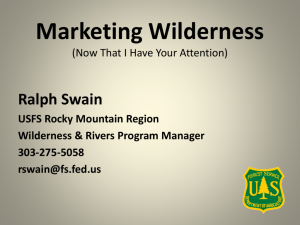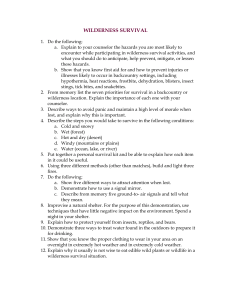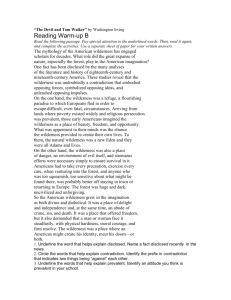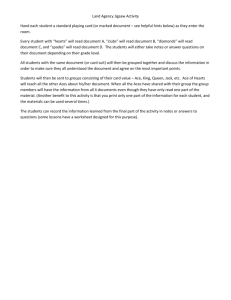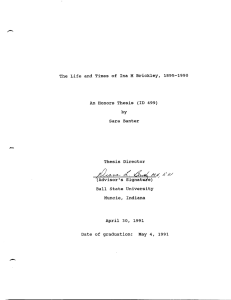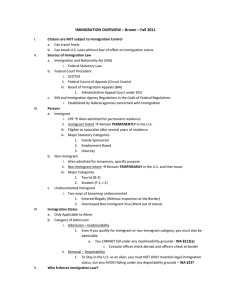Wilderness Information Needs Assessment (INA
advertisement
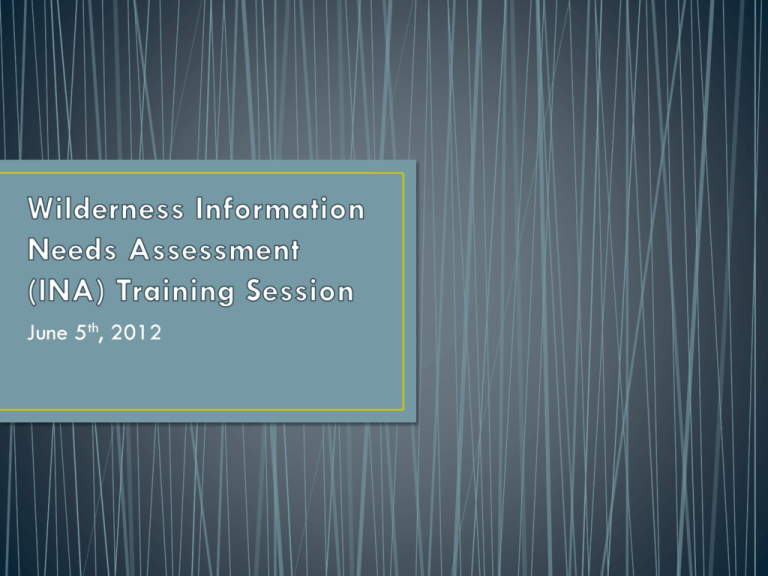
June 5th, 2012 1. 2. 3. 4. 5. Review basic terms, definitions Discuss benefits of conducting an INA Provide overview of INA process Review each step in INA process and discuss templates Wrap up, questions & answers Steve Boutcher (Burlington, VT) Wilderness Information Management Steering Team • “Information needs assessment”: a structured approach for determining data collection, storage and analysis needs by first identifying and prioritizing local management requirements. • “Data”: are raw, unorganized facts (often measureable, observable) • “Information”: is interpreted data • “Protocol”: A documented set of rules or instructions pertaining to the collection, analysis, or interpretation of data or information. 1. Information Planning 2. Data Collection 3. Data Storage & Analysis 4. Information Presentation & Use lifeform: tree species: spruce height: 93.1ft. dbh: 43.6in. Define business requirements Identify & prioritize data and information needs Standard protocols, definitions, codes, methods Field data collection Spatial mapping Appropriate technology Corporate info. systems Data storage & QA/QC Data sharing & integration Data summary Analysis Interpretation Reports Maps Performance measures Web sites 1. Conducting an INA helps to make efficient use of limited resources by focusing information management efforts on most pressing issues 2. Units completing an INA can claim 2-points on Element 9 of the 10 Year Wilderness Stewardship Challenge 3. Provides a structured opportunity to discuss resource integration and wilderness stewardship with other program areas – and to engage local line officers 4. Improves position for competing for NFRW and NFIM funding To develop a process that: 1. Provides focus to data collection, storage and analysis activities by first prioritizing the information needed to support the most critical wilderness stewardship decisions; 2. Makes the wilderness manager think through all aspects of their endeavor before work begins; 3. Encourages integration; 4. Is straight-forward and not overly complex; and 5. Is realistic in terms of time commitment. Stephen Covey “7 Habits of Highly Effective People” People may develop their own process but it should meet minimum criteria: • • • • • Must be wilderness-wide, at a minimum Must address full range of issues/concerns Must address entire life cycle of information needs INA should be developed by interdisciplinary team INA should be no older than 5-years Please share modifications to the process with Steve Boutcher (sboutcher@fs.fed.us) • • • • • • Step 1 – Identify Assessment Area Step 2 – Identify Issues of Concern and Assign Initial Priority Step 3 – Define Information Needs for Priority Issues Step 4 – Assign Priority Ranking to Issues Step 5 – Build a Realistic Work Plan Step 6 – Feedback • Completed Wilderness Threats Matrix • Wilderness INA Worksheet for each priority issues (with cost estimates) • Realistic 5-Year Work Plan • Step 1 – Identify Assessment Area: • Conducted for a single wilderness or it can be done for wildernesses managed as a complex only if the issues are similar • An INA should never be conducted for an area less than an entire wilderness • Step 2 – Identify Issues of Concern and Assign Initial Priority: • Best accomplished by convening representatives from the various resource staffs as well as line officers • Modify the threats matrix to represent the issues of greatest local concern • Modify the attributes of wilderness character to reflect specific or place-dependent aspects of a specific wilderness • Identify the top 3-6 information needs (expressed as an issue/threat on a specific attribute of wilderness character) • Step 2 – Identify Issues of Concern and Assign Initial Priority (continued): • Assignment of priorities should involve weighing: • Relative significance of the impact and existing state of knowledge • Urgency for management actions and/or the likely effectiveness of those actions • Relative workload • Public issues or concerns (key stakeholders) • Step 3 – Define Information Needs for Priority Issues: • Complete a Wilderness INA Worksheet (Appendix B) for each priority issue, working directly with resource specialists. • • • • • • • • • • • Issue/Threat Attribute(s) Affected Question(s) That Need to be Addressed Data Collection Needs (tabular & spatial) Data Collection Protocol Database Analysis Protocol Information Products (w/ examples) Information use Other Program Areas Involved Cost Estimate • Step 4 – Assign Priority Ranking to Issues: • Working either with the whole interdisciplinary group, or directly with the line officer, rank the priority information needs • Give honest consideration to existing and reasonably foreseeable staff and funding constraints • Be aware of opportunities to involve partners and leverage external funding sources • Step 5 – Build a Realistic Work Plan (Appendix C): • Plan should look ahead 5 years and should include: • Fiscal year • Issue / information need • Priority rank • Specific work items • Cost estimate • Possible funding sources • Timing • Responsibility • Step 6 - Feedback: • Re-evaluate the work plan each year, making adjustments as needed to either remove items as they are completed, add new items as experience is gained, or make other modifications due to changes in resource availability. • The entire INA should be revisited every 3-5 years to see if new issues / information needs have emerged, of if other previously ranked issues have fallen in their importance.




